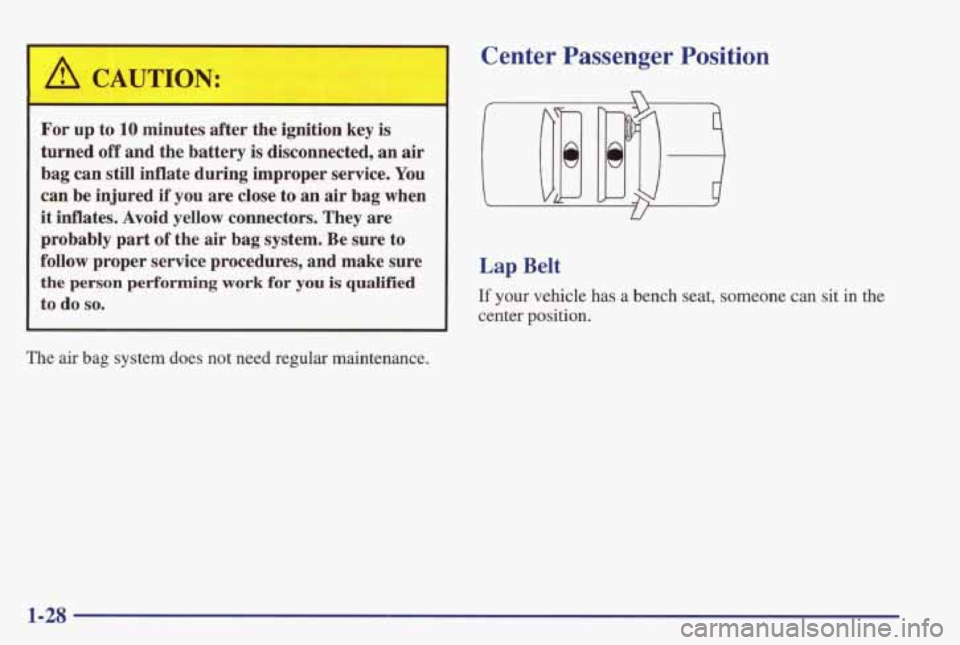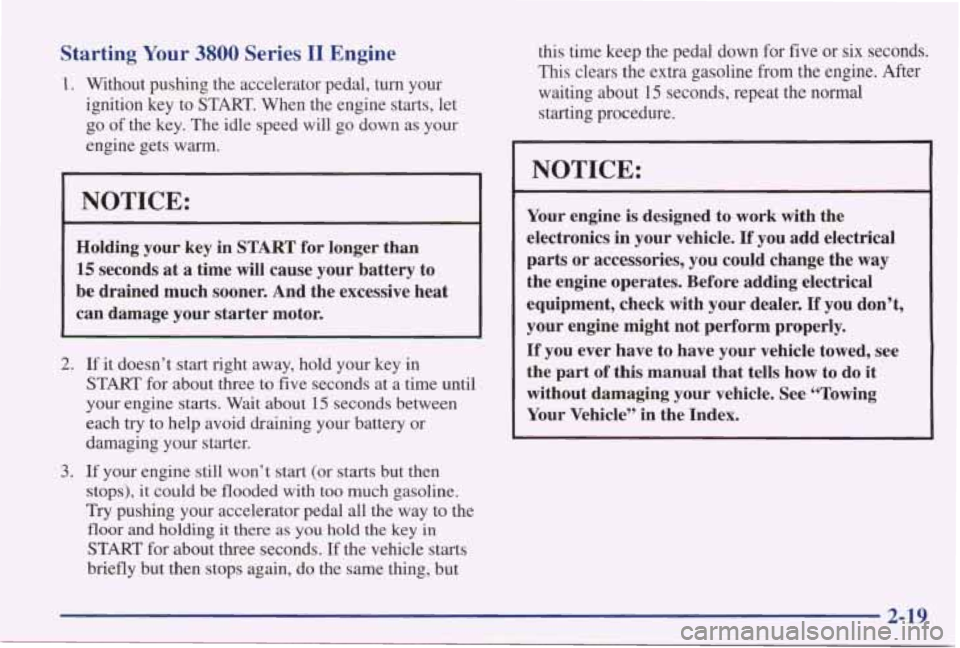1998 PONTIAC GRAND PRIX battery
[x] Cancel search: batteryPage 6 of 402

Vehicle Symbols
These are some of the symbols you may find on your vehicle.
For example,
these symbols are used on an
original battery:
POSSIBLE A
CAUTION
INJURY
PROTECT EYES BY
SHIELDING
CAUSTIC
I
BURNS I
AVOID
SPARKS
OR
FLAMES
SPARK
OR ,\I/,
COULD
FLAME
EXPLODE BAllERY
These symbols are important for you and
your passengers
whenever your
vehicle is
driven:
n
UNLOCK Fol
FASTEN
SEAT
BELTS
op
AIR BAG p
These symbols
have to do with
your lamps:
SIGNALS 6
TURN
PARKING
p$ LAMPS
FOG LAMPS
$0
These symbols are
on some of
your controls:
WINDSHIELD
WIPER
WINDSHIELD DEFROSTER
VENTILATING
1
These symbols are used on
warning and
indicator lights:
COOLANT
TEMP
-
CHARGING I-1
BAllERY
SYSTEM
BRAKE
(0)
h
ENGINE OIL
PRESSURE
Here are some
other symbols
you may see:
FUSE
LIGHTER
m
HORN tcr
SPEAKER
b
FUEL e3
V
Page 34 of 402

0
0
Your vehicle is equipped with a crash sensing and
diagnostic module, which records information about
the air bag system. The module records information about the readiness of the system, when the sensors
are activated and driver’s safety belt usage at deployment.
Let only qualified technicians work on your
air bag
system. Improper service can mean that your
air
bag system won’t work properly. See your dealer
for service.
NOTICE:
If you damage the covering for the driver’s or the
right front passenger’s air bag, the bag may not
work properly. You may have to replace the air
bag module in the steering wheel or both the air
bag module and the instrument panel for the
right front passenger’s air bag.
Do not open or
break the air bag coverings.
If your vehicle ever gets into a lot of water -- such as
water up to the carpeting
or higher -- or if water enters
your vehicle and
soaks the carpet, the air bag controller
can be soaked and ruined.
If this ever happens, and then
you start your vehicle, the damage could make the
air
bags inflate, even if there’s no crash. You would have to
replace the air bags as well as the sensors and related
parts. If your vehicle
is ever in a flood, or if it’s exposed
to water that soaks the
carpet, you can avoid needless
repair costs by turning
off the vehicle immediately.
Don’t let anyone
start the vehicle, even to tow it, unless
the battery cables are fist disconnected.
Servicing Your Air Bag-Equipped Vehicle
Air bags affect how your vehicle should be serviced.
There are parts of the air bag system in several places
around your vehicle. You don’t want the system to
inflate while someone is working on your vehicle. Your
dealer and the Grand
Prix Service Manual have
information about servicing your vehicle and the
air bag
system.
To purchase a service manual, see “Service and
Owner Publications” in the Index.
1-27
Page 35 of 402

A CAUTION:
For up to 10 minutes after the ignition key is
turned
off and the battery is disconnected, an air
bag can still inflate during improper service.
You
can be injured if you are close to an air bag when
it inflates. Avoid yellow connectors. They are
probably part of the air bag system. Be sure to
follow proper service procedures, and make sure
the person performing work for you is qualified
to do so.
The air bag system does not need regular maintenance.
Center Passenger Position
i3
Lap Belt
U
If your vehicle has a bench seat, someone can sit in the
center position.
1-28
Page 83 of 402

This device complies with RSS-210 of Industry Canada.
Operation
is subject to the following two conditions:
(1) this device may not cause interference, and (2) this
device must accept any interference received, including
interference that may cause undesired operation of
the device.
Changes or modifications to this system by other
than an
authorized service facility could void authorization to
use this equipment.
This system has a range of about 3 feet (1 m) up to
30 feet
(9 m). At times you may notice a decrease in
range.
This is normal for any remote keyless entry
system. If the transmitter does not work or if you have
to stand closer
to your vehicle for the transmitter to
work,
try this:
Check to determine if battery replacement is
necessary. See the instructions that follow.
0 Check the distance. You may be too far from your
vehicle.
You may need to stand closer during rainy
or snowy weather.
Check the location. Other vehicles or objects may be
blocking the signal. Take a few steps to the left or
right, hold the transmitter higher,
and try again.
If you’re still having trouble, see your dealer or a
qualified technician for service.
Operation
3-Button Key Fob 4-Button Key Fob
Remote All Door Lock
To lock all doors, press LOCK on the remote keyless
entry transmitter (see “Power Door Locks” in the Index
for more details on power
door lock features). If your
vehicle is equipped with
the Content Theft-Deterrent
system, the
LOCK button may arm the system
(see “Content Theft-Deterrent” in the Index for
more details).
2-8
Page 85 of 402

Matching Transmitter(s) To Your Vehicle
Each remote keyless entry transmitter is coded to
prevent another transmitter from unlocking your vehicle.
If a transmitter is lost or stolen, a replacement can be
purchased through your dealer. Remember to bring any remaining transmitters with
you when you go to your
dealer. When the dealer matches the replacement
transmitter
to your vehicle, any remaining transmitters
must also be matched. Once your dealer has coded the
new transmitter, the lost transmitter will not unlock your
vehicle. Each vehicle can have only four transmitters
matched
to it.
Battery Replacement
Under normal use, the battery in your remote keyless
entry transmitter should last about two years.
You can tell the battery is weak if the transmitter won’t
work at the normal range in any location. If
you have to
get close
to your vehicle before the transmitter works,
it’s probably time to change the battery.
I NOTICE:
When replacing the battery, use care not to touch
any of the circuitry. Static from your body
transferred to these surfaces may damage
the transmitter.
2-10
Page 86 of 402

.“‘-
1.
2.
3.
4.
To replace your battery: -
Insert a flat object like a dime into the slot on
the side of the transmitter and twist to separate
the halves.
Gently pry the battery out
of the transmitter. Do not
use metal flanges to
“pop out” the battery.
Put the new battery into the transmitter as shown on the transmitter. Use a type CR2032 battery,
or equivalent.
Reassemble the transmitter. Make
sure the halves are
snapped together tightly
so water will not get in.
5. Check the transmitter operation. If needed, follow
the instructions on resynchronizing your remote
keyless
entry transmitter.
Resynchronizing Your Remote Keyless
Entry Transmitter
Your remote keyless entry system uses a continually
changing code for increased security. Normally, the
receiver
in your vehicle will keep track of this
changing code.
Loss of synchronization will occur if the transmitter
is activated more than 256 times while out of range
of the vehicle.
0 Loss of synchronization will occur after battery
replacement if the transmitter is immediately
activated more than 16 times while out
of range of
the vehicle.
If your remote keyless entry transmitter has stopped working,
you may need to resynchronize the transmitter to the vehicle
receiver.
To do this, press the LOCK and UNLOCK buttons
together and hold for at least seven seconds or
until the horn
sounds, when equipped with Content Theft-Deterrent.
Check the remote keyless entry transmitter.
If attempts to resynchronize your transmitter to the
vehicle
are not successful, you may need to match the
transmitter
to the vehicle.
2-11
Page 93 of 402

NOTICE:
Don’t try to shift to PARK (P) if your Pontiac is
moving.
If you do, you could damage the
transaxle. Shift to
PARK (P) only when your
vehicle is stopped.
Starting Your 3100 Engine
1. Without pushing the accelerator pedal, turn your
ignition key to
START. When the engine starts, let
go of the key. The idle speed will go down as your
engine gets warm.
NOTICE:
Holding your key in START for longer than
15 seconds
at a time will cause your battery to
be drained much sooner. And the excessive heat
can damage your starter motor.
.
2. If your engine won’t start (or starts but then stops),
it could be flooded with too much gasoline.
Try
pushing your accelerator pedal all the way to the
floor and holding it there as you hold the key in
START for up to 15 seconds. This clears the extra
gasoline
from the engine.
NOTICE:
Your engine is designed to work with the
electronics
in your vehicle. If you add electrical
parts or accessories, you could change the
way
the engine operates. Before adding electrical
equipment, check with your dealer.
If you don’t,
your engine might not perform properly.
If you ever have to have your vehicle towed, see
the part of this manual
that tells how to do it
without damaging your vehicle. See “Towing
Your Vehicle” in the Index.
2-18
Page 94 of 402

Starting Your 3800 Series I1 Engine
1. Without pushing the accelerator pedal, turn your
ignition key to START. When the engine starts, let
go of the key. The idle speed will go down as your
engine gets
warm.
NOTICE:
Holding your key in START for longer than
15 seconds at a time will cause your battery to
be drained much sooner. And the excessive heat
can damage your starter motor.
2.
3.
If it doesn’t start right away, hold your key in
START for about three to five seconds at a time until
your engine starts.
Wait about 15 seconds between
each
try to help avoid draining your battery or
damaging your starter.
If your engine still won’t start (or starts but then
stops), it could be flooded with too much gasoline.
Try pushing your accelerator pedal all the way to the
floor and holding it there as you hold the key in
START for about three seconds.
If the vehicle starts
briefly but then stops again, do the same thing, but this time keep the pedal down
for five or six seconds.
This clears the extra gasoline from the engine.
After
waiting about 15 seconds, repeat the normal
starting procedure.
NOTICE:
Your engine isdesigned to work with the
electronics in your vehicle.
If you add electrical
parts
or accessories, you could change the way
the engine operates. Before adding electrical
equipment, check with your dealer.
If you don’t,
your engine might not perform properly.
If you ever have to have your vehicle towed, see
the part
of this manual that tells how to do it
without damaging your vehicle. See “Towing
Your Vehicle” in the Index.
2-19